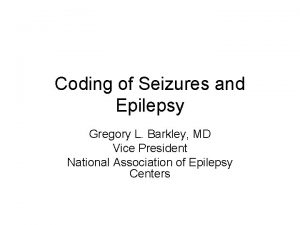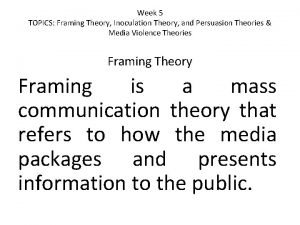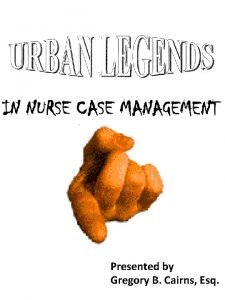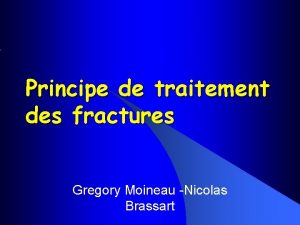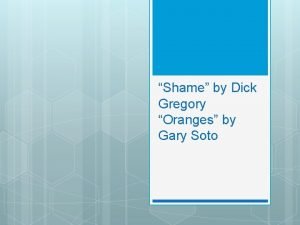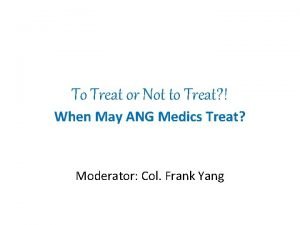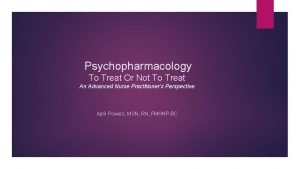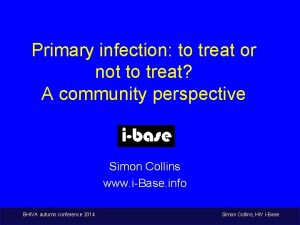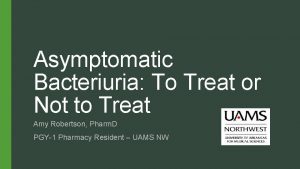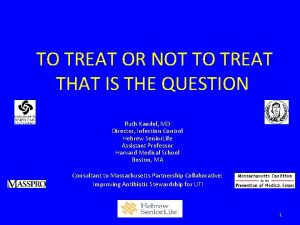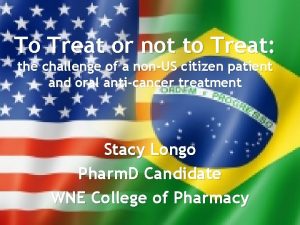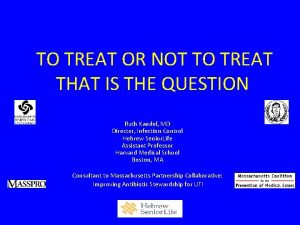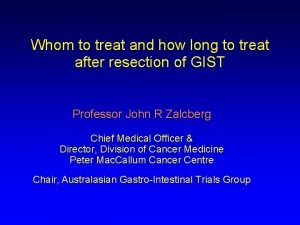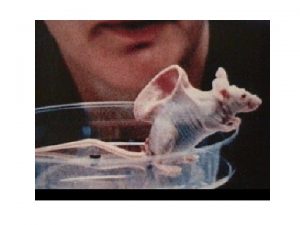To treat or not to treat Gregory De






































































- Slides: 70

To treat or not to treat? Gregory De. Clue, Ph. D. , ABPP 941 -951 -6674 gregdeclue@mailmt. com http: //gregdeclue. myakkatech. com/

To treat or not to treat a convicted sex offender who says he didn't do it: Implications of research regarding confessions and treatment


Nature photography is by Phillip Witt, Ph. D. phwitt@optonline. net

“You have been found guilty and you’ve been ordered to get treatment. Now you tell me you didn’t do it. …

… If you don’t admit that you committed the crime, then you cannot participate in this treatment program. …

… Oh, and by the way, your probation may be violated and you may go to prison. …

… So, do you want to admit you committed the crime or not? It’s your call. ”

19 Minimum number of centuries in prison served by U. S. convicts for crimes of which DNA evidence later exonerated them.

1996 year in which the FBI reported that in sexual assault cases in which DNA results could be obtained, the DNA evidence exonerated the primary suspect in 25% of the cases.

90 Estimated percent of felony cases in which there is no biologic evidence to test (e. g. , for DNA)

14 to 25 Percent of exonerations in which the person had given a false confession

Die The last thing a person will do before being released from prison, if he or she is convicted of capital sexual battery in Florida

> 90 Percent of criminal convictions achieved via plea (guilty or no contest) rather than trial

Some innocent people confess to crimes

Although DNA testing can allow some falsely accused – and some falsely convicted – people to prove their innocence, in some cases there is no biological evidence to test.

It is therefore critical to study cases where innocent people have been convicted and to identify what errors led to the wrongful convictions, so that the risk of such errors can be minimized in the future.

Why do Suspects Confess?

Self-incriminating admissions or confessions lead to serious negative consequences, commonly including adverse effects to self-esteem and integrity, loss of freedom and liberty, and possible financial penalties.

Police interrogation can be construed as a process of at least temporarily overcoming whatever factors inhibit a suspect from confessing.

• fear of legal sanctions • concern about one’s reputation • not wanting to admit to oneself what one has done • not wanting one’s family and friends to know about the crime • fear of retaliation

Nevertheless, the percentage of suspects who confess during police interrogation is substantial, ranging from under 40% to over 70% in various studies.

Gudjonsson: “The suspects’ behavior during the interrogation is likely to be more influenced by their perceptions, interpretations, and assumptions about what is happening than by the actual behavior of the police. …

… When the suspect perceives the evidence against him as being strong he is more likely to confess, believing that there is no point in denying the offense. ”

“Interrogation procedures are designed to encourage rational people to make decisions that no rational person would make outside of the context of the influence of modern police interrogation. ” – Richard Leo

During the shift from denial to admission, police use one set of tactics to alter the suspect’s perception of his immediate situation, and another set of tactics to communicate information to the subject about incentives to confess and disincentives for continued denial.

“The process of interrogation produces confession because it results in the suspect being convinced either that he has been caught (if he is guilty) or that his situation is hopeless (if he is innocent), that further denial is pointless, and that it is in his self-interest to confess. …

… For both innocent and guilty suspects, confessing is something neither would have chosen to do prior to the start of the interrogation and something each would have predicted he would have resisted to his last breath” (Ofshe & Leo, 1997, p. 194).

Social scientists who have analyzed interrogations report that there are no reliable, observable differences between interrogations yielding true or false confessions until after the “I did it” statement.

Therefore, police interrogation should never end at the point when the police believe the suspect has made admissions allowing him to be charged with the most serious offense possible.

During the postadmission narrative, interrogators elicit detailed descriptions of events. If the suspect provides accurate details showing special knowledge of the details of the crime, then the confession can be judged as reliable. *

If the suspect’s post-admission narrative does not match the facts of the case, the reliability of the confession is in doubt.

De. Clue, G. (2005). Interrogations and disputed confessions: A manual forensic psychological practice. Sarasota, FL: Professional Resources Press.


What do we know about sex-offender treatment?

Consider two key questions: • Does sex offender treatment reduce recidivism? • Do relapse-prevention components enhance treatment effectiveness?

Does sex offender treatment reduce recidivism? Hanson (2000) notes that there is one completed, published metaanalysis of sex offender treatment outcome (Hall, 1995). Hall found a small but significant treatment effect. …

However, re-analyses of the 12 studies in that meta-analysis found that the treatment effect could be wholly accounted for by studies that used dropouts/refusers as the comparison group (Harris et al. , 1998).

Hanson notes that studies have consistently reported lower recidivism rates for those who complete treatment than for those who drop out (Hanson & Bussiere, 1998), but that one cannot conclude from such studies that the treatment made the difference.

Some of the same offenders who are at increased risk to sexually reoffend may also be at increased risk to drop out of treatment because of lack of motivation, impulsiveness, or general belligerence.

Hanson concludes that "there have been insufficient studies to justify clear conclusions. "

Do relapse prevention (RP) components enhance treatment effectiveness (reduce relapse more than programs that do not have RP components)?

One way to address this question would be to conduct studies that randomly assign sex offenders into different types of treatment groups or a no-treatment control group.

An alternative research design compares current treatment programs that use RP techniques with previous treatment programs that did not. Marshall and Anderson's chapter in Laws (2000) et al. cites studies of two programs identified as having no RP elements in their treatment programs, which found no effects for treatment, and studies of six programs including RP, which all reported positive effects for treatment.

They interpret this as evidence that RP is more effective than other treatment approaches. However, none of these studies utilized a truly randomized design. Treated subjects were compared with a convenience sample of matched, contemporaneous untreated clients from the same setting.

To see how important this methodological issue is, consider the one study to date that has used a randomized design, the Sex Offender Treatment and Evaluation Project (SOTEP; Marques, Nelson, Alarcon, & Day, 2000).


De. Clue, G. (2002). Remaking relapse prevention with sex offenders: A source book, and Practice standards and guidelines for members of the Association for the Treatment of Sexual Abusers (ATSA). Journal of Psychiatry & Law, 30, 285 -292. (book review)

Does long-term treatment of sexually violent predators reduce recidivism? At this point, no one knows.

Some studies of recidivism after treatment have shown that people who complete sex-offender treatment have lower recidivism rates than people who were not treated, but due to methodological weaknesses it has been impossible to determine whether treatment has caused a decrease in recidivism risk.

People who undergo some treatment and then either drop out or are “kicked out” might be expected to show some improvement, but not as much improvement as those who complete the whole treatment program. Not so!

People who fail to complete treatment show greater reoffense rates than either people who completed treatment or people who had no treatment at all. Why?

Some of the same people who are at increased risk to sexually re-offend may also be at increased risk to drop out of treatment because of lack of motivation, impulsiveness, or general belligerence.

Thus treatment completion could be a marker variable for lower recidivism risk rather than a cause of it.

Consider a recent welldesigned study. Hanson, Broom, and Stephenson (2004) report:

“The treatment program examined in this study did not appear to be effective in reducing recidivism. …

… Although some analyses slightly favored one group or the other, the differences between the treated and untreated groups was virtually zero after controlling for year of release, follow-up time, and static risk factors. ”

De. Clue, G. (2005). Avoiding garbage 2: Assessment of risk for sexual violence after long-term treatment, Journal of Psychiatry & Law, 33, 179204.

CONCLUSIONS

1. Not everyone who is convicted of a crime is guilty. 2. Not everyone who confesses to a crime is guilty. 3. Some people enter “best interest” pleas.

4. Innocent people may be more prone to enter a “best interest” plea of guilt when a) the evidence suggests that a finding of guilt may be likely and b) the consequences of a guilty finding are expected to be severe.

5. So the person who has confessed to a sex crime and has been found guilty of the crime, and who agrees to participate in treatment, yet now says he did not really do it …

… may not be full of # 2.

And after all …

There is no clear empirical evidence that shows that an offender must admit guilt in order to benefit from sexoffender treatment …

… or that a sex-offender will benefit from treatment under any circumstances.

Therefore …

There appears to be no scientific basis for refusing to provide sex-offender treatment to a person who is willing to participate in treatment, but who claims he is innocent of the crime for which he was convicted.

By the way, what does it take to get counted as a sexual recidivist?

Gregory De. Clue, Ph. D. Sarasota, FL 941 -951 -6674 gregdeclue@mailmt. com http: //gregdeclue. myakkatech. com
 How do we treat the life the life how we treat
How do we treat the life the life how we treat Sadlier vocabulary workshop level d unit 1 synonyms
Sadlier vocabulary workshop level d unit 1 synonyms Gregory clayman
Gregory clayman Dr. gregory stanton
Dr. gregory stanton Gregory stoller
Gregory stoller Fotografo gregory colbert
Fotografo gregory colbert Gregory ahearn
Gregory ahearn Numerical analysis interpolation
Numerical analysis interpolation Pope gregory iii
Pope gregory iii Kate gregory c++
Kate gregory c++ Gregory delboe
Gregory delboe Comdiens
Comdiens Gregory snow
Gregory snow Gregory reznik
Gregory reznik Bernadette gregory
Bernadette gregory Gregory chanan
Gregory chanan Dr gregory barkley
Dr gregory barkley As were many colonial administrators gregory was
As were many colonial administrators gregory was Gregory marchildon
Gregory marchildon Rotary breakers
Rotary breakers Shame by dick gregory
Shame by dick gregory Gregory morton wikipedia
Gregory morton wikipedia Gregory and sampson
Gregory and sampson Gregory gutin
Gregory gutin Gregory chanan
Gregory chanan Eight stages of genocide
Eight stages of genocide Gregory sporton
Gregory sporton Gregory chanan
Gregory chanan Gregory kesden
Gregory kesden Inoculation marketing
Inoculation marketing Cairns and associates denver
Cairns and associates denver Gregory levitin
Gregory levitin Iisca
Iisca Metacommunication
Metacommunication Lecia sequist
Lecia sequist Dsw near me
Dsw near me James mc neelis
James mc neelis Ipds raytheon
Ipds raytheon Gregory winton
Gregory winton Dr gregory bernstein
Dr gregory bernstein Platre de graffin
Platre de graffin Gregory michiels
Gregory michiels Https://api.socrative.com/rc/
Https://api.socrative.com/rc/ Gregory frank harris pintor
Gregory frank harris pintor Jill gregory
Jill gregory Ryas gregory
Ryas gregory Gregory gardner md
Gregory gardner md Technology management cycle
Technology management cycle Dr don gregory
Dr don gregory Gregory cipriano
Gregory cipriano Arofan gregory
Arofan gregory Dr gregory hill
Dr gregory hill Professor simon gregory
Professor simon gregory Gregory pfp
Gregory pfp Principio del vuoto
Principio del vuoto Bernadette gregory
Bernadette gregory Gregory b jordan esq
Gregory b jordan esq Gregory top down theory of perception
Gregory top down theory of perception Gregory d. abowd
Gregory d. abowd Gregory cool
Gregory cool Arofan gregory
Arofan gregory Gregory harry
Gregory harry Interpolasi newton gregory
Interpolasi newton gregory Gregory kesden
Gregory kesden Gregory riely
Gregory riely David lynch
David lynch Gregory battcock
Gregory battcock Gregory coefficients
Gregory coefficients Shame by dick gregory summary
Shame by dick gregory summary Carla gregory
Carla gregory Transitions for descriptive essays
Transitions for descriptive essays
















